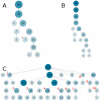DEFOG: discrete enrichment of functionally organized genes
- PMID: 22706384
- PMCID: PMC3469163
- DOI: 10.1039/c2ib00136e
DEFOG: discrete enrichment of functionally organized genes
Abstract
High-throughput biological experiments commonly result in a list of genes or proteins of interest. In order to understand the observed changes of the genes and to generate new hypotheses, one needs to understand the functions and roles of the genes and how those functions relate to the experimental conditions. Typically, statistical tests are performed in order to detect enriched Gene Ontology categories or pathways, i.e. the categories are observed in the genes of interest more often than is expected by chance. Depending on the number of genes and the complexity and quantity of functions in which they are involved, such an analysis can easily result in hundreds of enriched terms. To this end we developed DEFOG, a web-based application that facilitates the functional analysis of gene sets by hierarchically organizing the genes into functionally related modules. Our computational pipeline utilizes three powerful tools to achieve this goal: (1) GeneMANIA creates a functional consensus network of the genes of interest based on gene-list-specific data fusion of hundreds of genomic networks from publicly available sources; (2) Transitivity Clustering organizes those genes into a clear hierarchy of functionally related groups, and (3) Ontologizer performs a Gene Ontology enrichment analysis on the resulting gene clusters. DEFOG integrates this computational pipeline within an easy-to-use web interface, thus allowing for a novel visual analysis of gene sets that aids in the discovery of potentially important biological mechanisms and facilitates the creation of new hypotheses. DEFOG is available at http://www.mooneygroup.org/defog.
Figures




Similar articles
-
GOrilla: a tool for discovery and visualization of enriched GO terms in ranked gene lists.BMC Bioinformatics. 2009 Feb 3;10:48. doi: 10.1186/1471-2105-10-48. BMC Bioinformatics. 2009. PMID: 19192299 Free PMC article.
-
Ontologizer 2.0--a multifunctional tool for GO term enrichment analysis and data exploration.Bioinformatics. 2008 Jul 15;24(14):1650-1. doi: 10.1093/bioinformatics/btn250. Epub 2008 May 29. Bioinformatics. 2008. PMID: 18511468
-
MILANO--custom annotation of microarray results using automatic literature searches.BMC Bioinformatics. 2005 Jan 20;6:12. doi: 10.1186/1471-2105-6-12. BMC Bioinformatics. 2005. PMID: 15661078 Free PMC article.
-
Comparing algorithms for clustering of expression data: how to assess gene clusters.Methods Mol Biol. 2009;541:479-509. doi: 10.1007/978-1-59745-243-4_21. Methods Mol Biol. 2009. PMID: 19381534 Review.
-
Computational solutions for omics data.Nat Rev Genet. 2013 May;14(5):333-46. doi: 10.1038/nrg3433. Nat Rev Genet. 2013. PMID: 23594911 Free PMC article. Review.
Cited by
-
Modeling the genetic basis for human sleep disorders in Drosophila.Commun Integr Biol. 2013 Jan 1;6(1):e22733. doi: 10.4161/cib.22733. Commun Integr Biol. 2013. PMID: 23802043 Free PMC article.
References
Publication types
MeSH terms
Grants and funding
LinkOut - more resources
Full Text Sources

